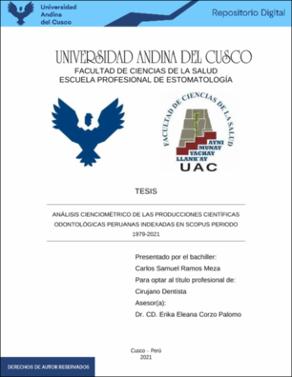| dc.contributor.advisor | Corzo Palomo, Erika Eleana | |
| dc.contributor.author | Ramos Meza, Carlos Samuel | |
| dc.date.accessioned | 2022-01-03T20:43:01Z | |
| dc.date.available | 2022-01-03T20:43:01Z | |
| dc.date.issued | 2021-11-26 | |
| dc.identifier.uri | https://hdl.handle.net/20.500.12557/4388 | |
| dc.description.abstract | La presente investigación muestra un estudio cienciométrico de las
producciones científicas odontológicas peruanas indexadas en Scopus, que
es una de las mayores bases de datos utilizada por la comunidad científica
respecto a diversos temas o disciplinas de interés. El objetivo principal de
investigación fue describir cómo ha evolucionado las producciones científicas
odontológicas peruanas indexadas en Scopus periodo 1979-2021. El método
empleado fue el análisis bibliométrico que se encarga de cuantificar ciertos
aspectos de la ciencia para poder comparar, medir y objetivar la actividad
científica, tomando como base de datos Scopus, incluyendo solo los
documentos con afiliación peruana en la disciplina estomatológica. Tras la
revisión bibliográfica, se analizaron 600 documentos. Se encontró que la
institución que produjo la mayor cantidad de documentos fue la Universidad
Peruana Cayetano Heredia (n=191; 31.83%). Por otro lado, la revista Journal
of Oral Research fue la que mayor producción alcanzó (78), seguido por la
Revista Cubana de Estomatología (41), y según la ley de Bradford que se
encarga de describir la relación cuantitativa entre las revistas y los documentos
científicos en un área específica se pudo apreciar que el 4.24% de las
principales revistas más productivas (5 revistas) desarrollaron 189
documentos, equivalente al 32.47% del total de documentos. Mayta-Tovalini
fue el autor que produjo el mayor número de documentos (55), y que según la
ley de Lotka que se encarga de la relación entre los autores y la producción
científica, los autores que solo realizaron dos publicaciones fue de 177;
aplicando la ley de Lotka se estimaba una producción de 162, por lo que se
cumplía la aproximación de producción. Las palabras claves concurrentes
fueron Human, Maxilla, Child, Male, Adolescent. La disciplina que se encontró
con mayor frecuencia fue la cirugía maxilofacial con 258 documentos. Se pudo
apreciar que en los últimos tres años se ha llegado a producir el 54.50% del
total de los documentos. Finalmente, se muestra un coeficiente de
determinación (R2) de 0.7804 y una media de producción de 13,95. | es_PE |
| dc.description.abstract | This research shows a scientometric study of the Peruvian dental scientific
productions indexed in Scopus, which is one of the largest databases used by
the scientific community regarding various topics or disciplines of interest. The
main research objective was to describe how the Peruvian dental scientific
productions indexed in Scopus period 1979-2021 have evolved. The method
used was the bibliometric analysis that is responsible for quantifying certain
aspects of science to compare, measure and objectify scientific activity, taking
Scopus as a database, including only documents with Peruvian affiliation in the
stomatological discipline. After the bibliographic review, 600 documents were
analyzed. It was found that the institution that produced the largest number of
documents was the Universidad Peruana Cayetano Heredia (n = 191; 12.11%).
On the other hand, the Journal of Oral Research was the one with the highest
production (78), followed by the Cuban Journal of Stomatology (41), and
according to Bradford's law, which is responsible for describing the quantitative
relationship between journals and Scientific documents in a specific area, it
could be seen that 4.24% of the main most productive journals (5 journals)
developed 189 documents, equivalent to 32.47% of all documents. MaytaTovalini
was
the
author
who
produced
the
largest
number
of
documents
(55),
and
according
to
the
Lotka
law
that
deals
with
the
relationship
between
authors
and
scientific production, the authors who only made two publications were
177; Applying Lotka's law, a production of 162 was estimated, thus the
production approximation was fulfilled. The concurrent keywords were Human,
Maxilla, Child, Male, Adolescent. The most frequently encountered discipline
was maxillofacial surgery with 258 documents. It could be seen that in the last
three years 54.50% of the total documents have been produced. Finally, a
coefficient of determination (R2) of 0.7804 and a mean production of 13.95 are
shown. | en_US |
| dc.format | application/pdf | es_PE |
| dc.language.iso | spa | es_PE |
| dc.publisher | Universidad Andina del Cusco | es_PE |
| dc.rights | info:eu-repo/semantics/openAccess | es_PE |
| dc.rights.uri | https://creativecommons.org/licenses/by-nc-nd/4.0/ | es_PE |
| dc.subject | Cienciometría | es_PE |
| dc.subject | Bibliometría | es_PE |
| dc.subject | Producciones científicas | es_PE |
| dc.title | Análisis cienciométrico de las producciones científicas odontológicas peruanas indexadas en Scopus periodo 1979-2021 | es_PE |
| dc.type | info:eu-repo/semantics/bachelorThesis | es_PE |
| thesis.degree.name | Cirujano Dentista | es_PE |
| thesis.degree.grantor | Universidad Andina del Cusco. Facultad de Ciencias de la Salud | es_PE |
| thesis.degree.discipline | Estomatología | es_PE |
| dc.publisher.country | PE | es_PE |
| dc.subject.ocde | https://purl.org/pe-repo/ocde/ford#3.02.14 | es_PE |
| renati.advisor.dni | 41816178 | |
| renati.advisor.orcid | https://orcid.org/0000-0002-4911-0601 | es_PE |
| renati.author.dni | 42760429 | |
| renati.discipline | 911016 | es_PE |
| renati.juror | Arenas Fernández Dávila, Jesús Alejandro | |
| renati.juror | Alanya Ricalde, José Antonio | |
| renati.juror | Gamero Huarcaya, Valery Kimiyo | |
| renati.juror | Cabrera Cuentas, Rocio | |
| renati.level | https://purl.org/pe-repo/renati/level#tituloProfesional | es_PE |
| renati.type | https://purl.org/pe-repo/renati/type#tesis | es_PE |


